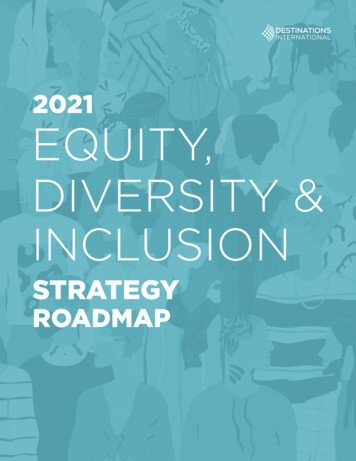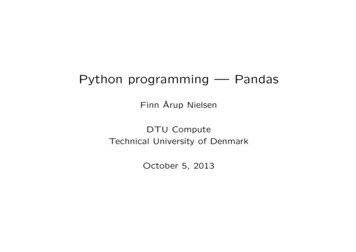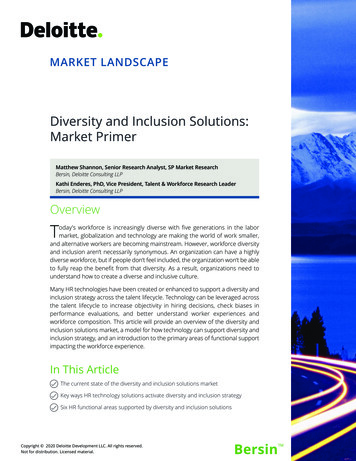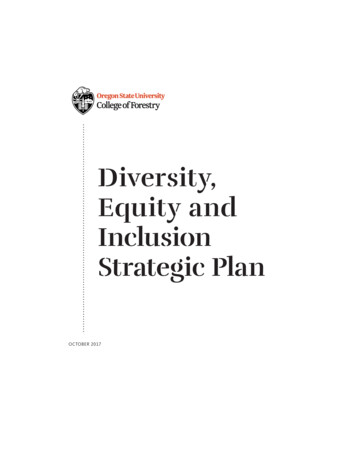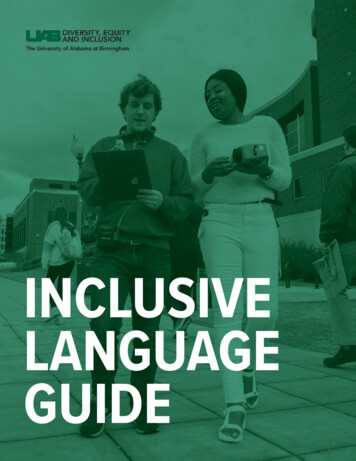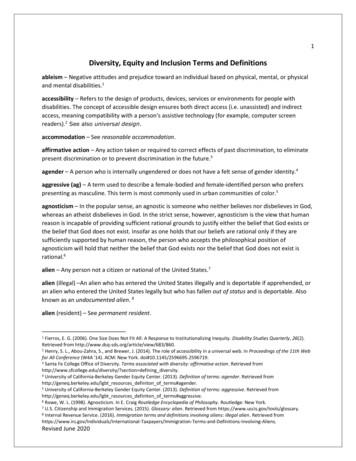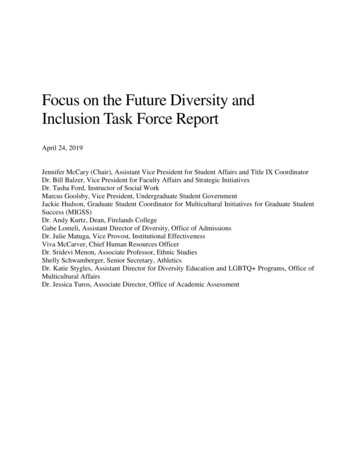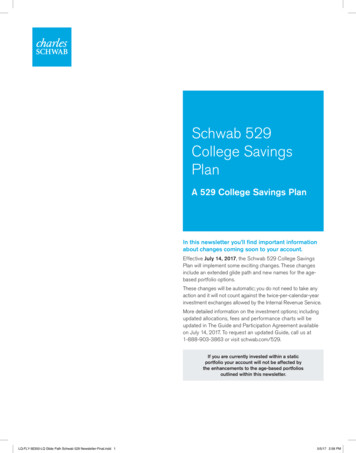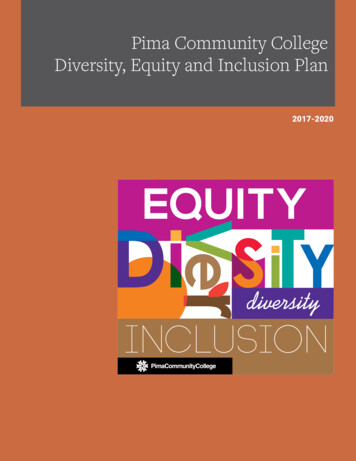
Transcription
Pima Community CollegeDiversity, Equity and Inclusion Plan2017-20201
Pima Community CollegeDiversity, Equity and Inclusion Plan2017-2020May 2017Co-authors: Ricardo Castro-Salazar, Alison Colter-Mack, Suzanne Desjardin,Dolores Durán-Cerda, Damian Montoya, Lorraine Morales and Rosalía SolórzanoDiversity Plan Subcommittee of the PCC Standing Committee on DiversityBoard Policy 2.01 Diversity: Pima Community College values its diverse student andemployee populations and is committed to providing and supporting programs, servicesand training that will enable all students and employees to achieve their educationaland career objectives. The same value will be utilized by PCC in employee recruitmentand hiring. In order that College employees reflect the diversity of the students and itscommunity, reasonable good faith efforts will be made to recruit highly qualified anddiverse applicants. (Revised in Oct. 28, 2014)Pima Community College is an equal opportunity, affirmative action employer and educational institution committed to excellencethrough diversity. Upon request, reasonableaccommodations will be made for individuals with disabilities. Every effort will be madeto provide reasonable accommodations in atimely manner. For public and employee accommodation requests, as well as information related to the ADA complaint process,contact the College ADA Coordinator at520-206-4539 or 4905C E. Broadway Blvd.,Tucson, AZ 85709-1130. For PCC studentaccommodation requests, please contactAccess and Disability Resources, 520-2066688 or adrhelp@pima.edu.i
Caminante no hay camino,se hace camino al andar.[Walker, there is no path,the path is made by walking.]— Poet Antonio Machadoii
ContentsIntroduction . . . . . . . . . . . . . . . . . . . . . . . . . . . . . . . . . . . . . . . . . . . . . . . . . . . . . . . . . . . . . . . . . . . . . 1PCC 2014 –2017 Strategic Plan . . . . . . . . . . . . . . . . . . . . . . . . . . . . . . . . . . . . . . . . . . . . . . . . . . . . . .2Institutional Goal/Statement of Aspiration . . . . . . . . . . . . . . . . . . . . . . . . . . . . . . . . . . . . . . . . . . . 3Why Diversity, Equity, and Inclusion? . . . . . . . . . . . . . . . . . . . . . . . . . . . . . . . . . . . . . . . . . . . . . . .4Diversity, Affirmative Action and Equal Employment Opportunity . . . . . . . . . . . . . . . . . . . . . . 5Equity . . . . . . . . . . . . . . . . . . . . . . . . . . . . . . . . . . . . . . . . . . . . . . . . . . . . . . . . . . . . . . . . . . . . . . . . . . .6Diversity and PCC demographics . . . . . . . . . . . . . . . . . . . . . . . . . . . . . . . . . . . . . . . . . . . . . . . . . . .7The process . . . . . . . . . . . . . . . . . . . . . . . . . . . . . . . . . . . . . . . . . . . . . . . . . . . . . . . . . . . . . . . . . . . . . .8Diversity, Equity and Inclusion Forum . . . . . . . . . . . . . . . . . . . . . . . . . . . . . . . . . . . . . . . . . .8Governing Board insights . . . . . . . . . . . . . . . . . . . . . . . . . . . . . . . . . . . . . . . . . . . . . . . . . . . . .9Strategic Goal 5 in Context . . . . . . . . . . . . . . . . . . . . . . . . . . . . . . . . . . . . . . . . . . . . . . . . . . . .9A Final Word . . . . . . . . . . . . . . . . . . . . . . . . . . . . . . . . . . . . . . . . . . . . . . . . . . . . . . . . . . . . . . .102017-2020 Diversity and Inclusion Plan: Goals and Objectives . . . . . . . . . . . . . . . . . . . . . . 11Strategic Goal 1 . . . . . . . . . . . . . . . . . . . . . . . . . . . . . . . . . . . . . . . . . . . . . . . . . . . . . . . . . . . . . 11Strategic Goal 2 . . . . . . . . . . . . . . . . . . . . . . . . . . . . . . . . . . . . . . . . . . . . . . . . . . . . . . . . . . . . . 12Strategic Goal 3 . . . . . . . . . . . . . . . . . . . . . . . . . . . . . . . . . . . . . . . . . . . . . . . . . . . . . . . . . . . . . 13Strategic Goal 4 . . . . . . . . . . . . . . . . . . . . . . . . . . . . . . . . . . . . . . . . . . . . . . . . . . . . . . . . . . . . . 14Strategic Goal 5 . . . . . . . . . . . . . . . . . . . . . . . . . . . . . . . . . . . . . . . . . . . . . . . . . . . . . . . . . . . . . 15Strategic Goal 6 . . . . . . . . . . . . . . . . . . . . . . . . . . . . . . . . . . . . . . . . . . . . . . . . . . . . . . . . . . . . . 17AppendicesCollege Diversity Statement . . . . . . . . . . . . . . . . . . . . . . . . . . . . . . . . . . . . . . . . . . . . . . . . . . . . . . . 18Chancellor’s Diversity Message . . . . . . . . . . . . . . . . . . . . . . . . . . . . . . . . . . . . . . . . . . . . . . . . . . . . 19Standing Committee on Diversity: Charge/Membership . . . . . . . . . . . . . . . . . . . . . . . . . . . . . 20Glossary of Terms . . . . . . . . . . . . . . . . . . . . . . . . . . . . . . . . . . . . . . . . . . . . . . . . . . . . . . . . . . . . . . . .22Study of PCC students, faculty, and staff ethnicity . . . . . . . . . . . . . . . . . . . . . . . . . . . . . . . . . . .25It should be noted that demographic data is self-reported,hence is fluid and is a snapshot of a moment in time .For more information Diversity Webpage: pima.edu/about-pima/diversity Standing Committee on Diversity: pima.edu/about-pima/diversity/resources.html Questions? PCC-diversity@pima.eduiii
Executive SummaryThe Pima Community College 2017-2020 Diversity, Equity and Inclusion Plan is anextension of the College’s ongoing Strategic Planning process and is emblematic of theculture of continuous improvement that has taken hold at PCC . It is the result of work by aseven-person subcommittee of the Diversity Standing Committee and derives directly fromBoard Policy 2 .01, Diversity .Highlights The plan consists of six Strategic Goals that drive a total of 26 objectives . Goals are: Establish a sustainable Diversity, Equity and Inclusion (DEI) infrastructure,including hiring a DEI officer Improve recruitment and retention of employees from underrepresentedpopulations Build diversity and inclusion competencies for employees Establish and/or strengthen partnerships with organizations that provideservices to underrepresented populations in Pima County Enhance and increase students’ diversity and inclusionPrepare students, faculty and staff to adapt and succeed in a diverse, global,multicultural and multi-ethnic societyPlan includes an Aspirational Statement loosely aligned with the Strategic Plan’sAchieve60 goal .The Plan, the first of its kind in the College’s history, has evolved substantiallysince work began in 2015 . Throughout the process, the subcommittee has sought tocollaborate with external constituents . For example, the February 2017 Diversity Forum resulted in at least 12 majorchanges, including stronger emphasis on engaging external constituents intheir communities, and the addition of objectives related to curriculum .While the Plan includes Strategic Goal 5, which focuses on global education, theCollege embraces that its prime responsibility is to Southern Arizonans, especiallyits underrepresented, marginalized communities .The College will address equity as part of its greater EEO responsibilities toemployers as well as through a targeted commitment to our students to implementan Inclusive Excellence model .College work toward increased diversity will comply with applicable legalrequirements and use approaches that promote an atmosphere of welcome andinclusion . For example, while data on demographics can be useful to monitor diversity,the College will not use hiring preferences or specific quotas based on race,color, ethnicity, or any other impermissible criteriaPCC understands it must continue to be responsive to the changing needs andexpectations of our diverse communities .iv
IntroductionThe Pima Community College 2017-2020 Diversity, Equity and Inclusion Plan is anevolving, dynamic, living document . It is emblematic of the continuous improvement thathas taken hold at PCC . The Plan has been and will continue to be scrutinized by internaland external stakeholders, who will suggest alternative approaches . The revision process isto be embraced, as the document will drive adjustments in project direction, assumptions,processes, and actions . The Diversity, Equity and Inclusion Plan is meant to be an agent ofchange meeting the challenges and the needs of the College and its constituents .The Plan is an extension of the College’s ongoing Strategic Planning process . The Planprovides a framework for addressing themes and topics embedded in the College’sinstitutional DNA:Chancellor Lee D. Lambert’s “North Star” Student success Community engagement DiversityPCC Core Theme and Objective of Diversity, Inclusion and Global Education Expand and support the diversity of the College’s student population Close the achievement gap Expand and support the diversity of the College’s workforce Develop and increase the student population through global education1
PCC 2014-2017 Strategic PlanStrategic Direction 2: Improve access and student success2.3.Increase college enrollment, especially first-generation college students,adult students age 25 and older, Hispanic students, and students from otherunderrepresented populationsStrategic Direction 3: Foster partnerships to strengthen educational opportunities inresponse to community needs.3.1.Rebuild PCC image and build a more trusting relationship between PCC andtraditionally marginalized populations3.3.Expand community partnership to more fully engage all demographic segmentsassociated with traditionally marginalized populations3.5.Develop community-based partnerships to encourage enrollment in collegeStrategic Direction 5: Increase diversity, inclusion and global education5.3.Diversify the workforce of Pima Community College .Diversity, equity and inclusion are integral to student success, community engagementand virtually all College operations . Thus, the Plan takes a broad, holistic approach toits primary focus, student success . To achieve student success, it is necessary to closeachievement gaps and increase attainment rates . It also is necessary to examine theinstitution’s internal culture and practices, as well as how it interacts and collaborateswith the outside world, in order to recognize how they impact our ability to help studentssucceed .The Plan recommends actions that initiate, build on, expand and strengthen Collegeactivities that can leverage the diversity of our community to benefit the constituencieswe serve . It translates the aspirations of the College and the community regardingdiversity, equity and inclusion into a series of goals and objectives, with the understandingthat specific strategies and tactics; funding sources; indicators of effectiveness andaccountability; and processes for ongoing review and revision will be adjusted as planningmoves forward .2
Institutional Goal/Statement of AspirationClosing the educational attainment gap among Hispanics/LatinosThe jobs of the future will require more than a high school diploma . It is estimated that by2020, 30 percent of all jobs will require some college or an associate’s degree, and another35 percent will require a bachelor’s degree .Unfortunately, our community’s Hispanic/Latino residents have a lower educationalattainment level than other demographic groups . Within Pima County, 28 .7 percent ofresidents aged 25 and over are Hispanic/Latino . Yet among county residents 25 and olderwith a bachelor’s degree or higher, only 12 .9 percent are Hispanic/Latino .Hispanic/Latino residents of Pima County who lack postsecondary education facediminished job prospects and likely lower lifetime earnings, as jobs that require only ahigh school diploma historically are low-paid . Collectively, the gap in educationalattainment represents a profound challenge for our community .The College accepts the challenge . Recognizing that we are an intersection point for K-12and university education, and that we are uniquely positioned to educate workers who willpower our region’s businesses and industries, the College is setting the aspirational goalof closing the gap on educational attainment for Hispanic/Latino Pima County residents,so that in 20 years, the proportion of Hispanic/Latino residents aged 25 and over with abachelor’s degree or higher mirrors the proportion of Hispanic/Latino residents aged 25and older .Pima County’s collective prosperity increasingly will depend on an educated, skilledworkforce that can thrive in a 21st century economy . We seek to shift the needle onHispanic/Latino educational attainment in order to further the county’s overalleconomic development .3
Why Diversity, Equity and Inclusion?As it has throughout its history, Pima Community College strives to create a climate andculture in which positive attitudes toward diverse, interconnected groups are the norm andwhere increased involvement and academic growth is fostered . PCC values the enrichmentthat the unique perspectives and experiences individuals bring to the College and seeksto create an environment where these unique perspectives can coexist and flourish . Thedifferences between people that can engender these unique perspectives can include, butare not limited to, age, disability, ethnicity, gender, nationality, race, color, indigeneity,socioeconomic status, language, educational history, educational goals, geography, andLGBTQ status . The College is mindful that diversity is a journey, and that we may incurinstitutional resistance . However, we remain resolute to reach our overarching goal:ensuring the dignity and authenticity of the individual, and harmony among individuals .The close relationship between Diversity, Equity and Inclusion and Inclusive Excellence, atopic mentioned at the Diversity and Inclusion Forum on Feb . 10, 2017 (see more on thisimportant event below), should be noted . Inclusive Excellence is commonly defined insimple terms as the recognition that a community or institution’s success is dependenton how well it values, engages and includes the rich diversity of students, staff, faculty,administrators, and alumni . (For a more robust definition, see Glossary of Terms).4
Diversity, Affirmative Action, Equal Employment Opportunity (EEO)The Diversity and Inclusion Plan focuses on promoting inclusion and enhancingengagement to create a welcoming and safe environment for the College’s diversecommunities, not on enforcing compliance with government laws, regulations and rules .Existing entities at the College are responsible for assuring compliance:Affirmative Action (AA): PCC’s Affirmative Action Plans are administered out of andenforced by the College’s Equal Employment Opportunity (EEO) Office .Executive Order 11246 supports that to be in compliance with the Office of FederalContract Compliance Programs (OFCCP) federal contractors must demonstrate thataffirmative action has been taken “ by covered employers to recruit and advance qualifiedminorities, women, persons with disabilities and covered veterans ” veactAs a federal contractor, PCC supports compliance with OFCCP and effective January 2017is implementing the College’s annual Affirmative Action Plan (AAP), which focuses onutilization, underutilization and availability with emphasis placed on minorities, peoplewith disabilities, and covered veterans . In compliance with OFCCP, AAPs are developedand implemented by the College . AAPs are updated annually and must be kept on file aslong as the employer is considered a federal contractor under OFCCP standards .Equal Employment Opportunity (EEO): PCC’s EEO office also has oversight for enforcingthe College’s non-discrimination policy and compliance with Title VII of the Civil RightsAct of 1964, which prohibits discrimination on the basis of race, color, religion, sex(including pregnancy, gender identity, and sexual orientation), national origin, age (40or older) disability or genetic information . PCC’s non-discrimination policy reinforcesprotections under Title VII and also prohibits discrimination based on veteran status andother legally protected categories . Violations of Title VII and College policy are investigatedto correct any discriminatory acts and/or behaviors that may have occurred . All membersof the College community are committed to participating in the creation of a learning and/or work environment that is free of discrimination .5
EquityIn benchmarking our peer institutions and expanding our review to include nationaltrends, the Diversity Plan Subcommittee found that institutions in higher educationare addressing equity in a variety of ways . Equality is understood as the proportionaldistribution or parity of desirable outcomes across groups . Sometimes it is confusedwith equity . Equity refers to outcomes, while equality connotes equal treatment whereindividuals or groups are dissimilarly situated, equal treatment may be insufficient for oreven detrimental to equitable outcomes (Williams, 2013) .Often, equity is only addressed under legal auspices within an EEO framework foremployees . If it is explicitly discussed from a student focus, it is usually part of an InclusiveExcellence framework, addressing the need to close student achievement gaps whichstatistically tend to disproportionately impact underrepresented minority groups .We have chosen to address equity as part of our greater EEO responsibilities to ouremployees as well as through a targeted and intentional commitment to our students toimplement an Inclusive Excellence transformative model to shift our institutional culture .The AACU, American Association of Colleges and Universities, (2015) highlights specificactions to work toward equity-minded outcomes for students . See: dEquity.pdf (pages 25-26) .The College’s efforts are aligned with all 10 of these recommended AACU strategies .6
Diversity and DemographicsPima Community College aspires to a future in which its student body and workforce,including faculty, staff, and administrators, reflect well the diversity of the local PimaCounty community. College work toward increased diversity will comply with applicablelegal requirements and use approaches that promote an atmosphere of welcome andinclusion. For instance, while data on demographics can be useful to monitor diversity, theCollege will not use hiring preferences or specific quotas based on race, color, ethnicity, orany other impermissible criteria. Similarly, the College will maintain its practice of seekingdemographic information from applicants only on a voluntary basis and respecting theright of individuals to self-identify. Finally, the College will remain committed to recruitingqualified applicants from across the nation.7
The ProcessIn 2016 the College released a draft Diversity Plan, the first in its history . The plan wasshared with academic/diversity professionals from Tucson and across the U .S ., as wellas several experts attending the Hispanic Association of Colleges and Universitiesannual convention .The College sought feedback from internal and external constituency groups . Membersof the Governing Board, Chancellor Lambert, and College administrators received insights,which were passed on to the Diversity Committee . In all, the feedback from some 25external individuals and groups, combined with internal feedback, totaled more than50 pages .Overwhelmingly, the most common criticism of the draft was that it attempted to placediversity and inclusivity on a par with international/global education . Some critics believedthat emphasizing international/global education would be to the detriment of local,marginalized populations . The College was encouraged to write a plan addressing diversity,inclusivity and the challenges faced by underrepresented, marginalized communities,independent of issues related to internationalization and global education . Critics said thatas a Hispanic-Serving Institution (more than 43 percent of PCC’s students are Hispanic),PCC had an obligation to respond to the needs of southern Arizona’s Hispanics andLatinos, who include first-generation, multicultural, underprepared, underserved andother cohorts, as well as other underrepresented groups in Pima County .Diversity and Inclusion ForumOn Feb . 10, 2017, PCC held a Diversity and Inclusion Forum at Downtown Campus . A totalof 116 people participated in roundtable discussions regarding the February 2017 draftof the Diversity and Inclusion Plan, which had been posted on the College website onFeb . 3 . PCC employees from most of our six campuses, along with community members,attended . Twenty-four students from different ethnic backgrounds, who were invited byfaculty and staff, as well as those who came on their own, also attended . An Internationalstudent, a native of South Korea, attended, as did two refugee students .Each of the tables reported its insights for improving the Plan . Together, forum participantsgenerated 203 concepts, in the form of suggestions, concerns or questions . The DiversityPlan carefully considered all feedback, mapping each to a specific Plan goal or objective .The mapping revealed that out of those 203 concepts, at least 46 percent were alreadyembedded in the Plan’s goals and objectives, or in existing College goals or initiatives, suchas enhancing strategic partnerships with industry and K-12; improving resources for studentcareer development and networking; improving soft skills training; and providing courseschedules more optimally, at times when students most want them .8
New concepts were folded into the Plan itself or into the accompanying narrative,resulting in more than a dozen substantive changes in the draft . Among the mostimportant outcomes from the forum:Stronger emphasis on community engagement, Strategic Goal 3: The College definesstrategic engagement as an ongoing collaboration with external constituencies to addressan issue of mutual concern . The College has added additional objectives that broadenthe role of community groups in recruiting, retention, and completion . The College alsorewrote one of the goal’s objectives to reflect the necessity of taking PCC resources intothe community and meeting constituents where they live .Addition of objectives relating to curriculum: The objectives place Diversity and Inclusiontopics into Program Review and Unit Planning processes, and direct the Diversity andInclusion Officer, in collaboration with the Provost’s Office, to create instruments to assesshow Diversity and Inclusion topics are being infused into PCC curriculum .Recognition of the need for physical space: In an illustration of how development of aDiversity and Inclusion Plan can affect overall College strategic planning, the College’sEducation and Facilities Master Plan process will be amended to begin assessing needs forareas devoted to promoting diversity and inclusion .In short, the critics spoke and the College listened, as it has throughout development ofthe Plan .The substantial revisions to the Plan are reflective of the College’s sincere embrace ofcollaboration with its constituents . The College lived up to the powerful promise inherentin collaboration, one that goes beyond pledges to consult or involve . In accordance withInternational Association of Public Participation precepts, PCC has looked to the publicfor direct advice and innovation in formulating solutions, and has incorporated thoserecommendations to a significant extent .Governing Board insightsThe draft plan was presented to the Pima County Community College Governing Boardas an information item at its March Regular Meeting . The Board directed the plansubcommittee to add an Aspirational Statement to the plan, and to make other changes,which the subcommittee has included in this draft . The reality is that this plan is a first forPCC, and that while the plan is not perfect, it is good . Even more importantly, we recognizewe have to start somewhere . The first year of the plan will provide baseline data that willinform and drive future efforts in this important area .9
Strategic Goal 5 in ContextAs noted previously, a common criticism of the 2016 Draft Plan was that it attempted toplace diversity and inclusivity on par with international/global education . That concernwas expressed by some forum participants who believed the College was overemphasizinginternational/global education in the draft released Feb . 3, 2017 .It should be noted that while the Draft Plan still includes Strategic Goal 5, which is focusedon global education, the College acknowledges and embraces that its prime responsibilityis to Southern Arizonans, especially its underrepresented, marginalized communities .Further, our students and communities will reap the maximum benefit if the Collegetreats localism and globalism as complementary, not opposing, forces . For example,PCC’s Center for International Education and Global Engagement (CIEGE) is committedto work in accordance with the U .N . Universal Declaration of Human Rights, the U .N .Declaration of Rights of Indigenous Peoples, and the U .N . Convention on Migrants’ Rights,the Covenant on Economic Social and Cultural Rights, and the Convention on Eliminationof Discrimination Against Women . This universal approach envisions global networks andalliances on indigeneity, LGBTQ, disability and women’s rights as support systems forempowerment in the U .S . and vice versa .Global solidarity is the humanizing force of the global economy . As PCC ChancellorLee D . Lambert has written, “The 21st century’s global economy will value transnationalleadership skills, fluency in multiple languages, and respect for and understanding of othercultures .”A Final WordPCC looks forward to continued collaboration . PCC understands the College mustcontinue to be responsive to the changing needs and expectations of our diversecommunities . In that way we will keep alive the Diversity and Inclusion Plan, and thehope inherent in it .10
2017-2020 Diversity and Inclusion Plan:Goals and ObjectivesStrategic Goal 1:Establish a sustainable Diversity, Equity and Inclusion infrastructure.Aligns with:Core Theme and Objective of Diversity, Inclusion and Global Education: Expand and support the diversity of the College’s student population Expand and support the diversity of the College’s workforce .2014-2017 Strategic Plan: 2.3. Increase college enrollment, especially first -generation college students,students over 25, Hispanic students, and other underrepresented populations . Strategic direction 5.3: Diversify the workforce of Pima Community CollegeDraft 2017-2021 Strategic Plan: Strategic direction 3: Cultivate institutional excellence through continuousimprovementObjectiveActionUnit(s) of measurementHire a Diversity, Equity andInclusion Officer.Regular Diversity, Equity andInclusion Officer participationin meetings of the ExecutiveLeadership Team and otherCollege leadership groups;regular meetings with externalconstituents.Transform Standing Committeeon Diversity into Diversity, Equityand Inclusion Advisory CouncilCreate an Office of Diversity,Equity and inclusionNumbers ofmeetings,interactions withinternal, external e Chancellor for HumanResources, ProvostDiscovery sessions completed.Job posting scheduled forMay, selection process tobegin in July, with hiring goalof November 2017. PCC isexploring direct appointment ofInterim officer in May 2017.Diversity, Equity and InclusionOfficerEvaluate 2017-18 data in Spring2018Diversity Standing Committeewill recommend membership toChancellorJune 30, 2017June 30, 201811
Strategic Goal 2Improve recruitment and retention of employees from underrepresented populations.Aligns with:Core Theme and Objective of Diversity, Inclusion and Global Education: Expand and support the diversity of the College’s workforce2014-2017 Strategic Plan Strategic direction 5 .3: Diversify the workforce of PCCDraft 2017-2021 Strategic Plan: Strategic direction 3: Cultivate institutional excellence through continuousimprovementObjeObjectiveActionUnit(s) of measurementResponsible administrator(s)TimelineCreate applicantpools that reflectthe diversity of thecommunity.Regular monitoring of applicantpoolsApplicant pool dataVice Chancellor for HumanResources; EEO Office; Diversity,Equity and Inclusion OfficerEstablish baseline data andevaluate 2017-18 data in Spring2018Regular monitoring of searchcommittee membershipSearch committee membershipdataVice Chancellor for HumanResources, EEO Office; Diversity,Equity and Inclusion OfficerEstablish baseline data andevaluate 2017-18 data in Spri
Executive Summary The Pima Community College 2017-2020 Diversity, Equity and Inclusion Plan is an extension of the College's ongoing Strategic Planning process and is emblematic of the culture of continuous improvement that has taken hold at PCC . It is the result of work by a

